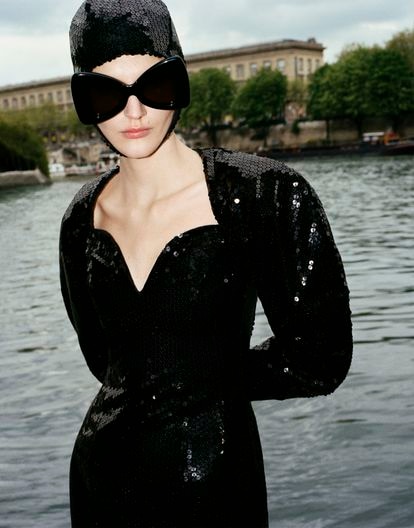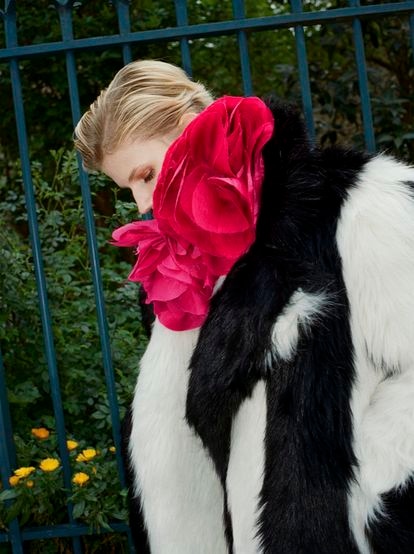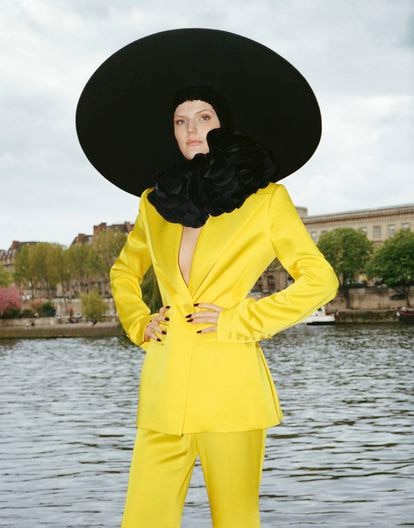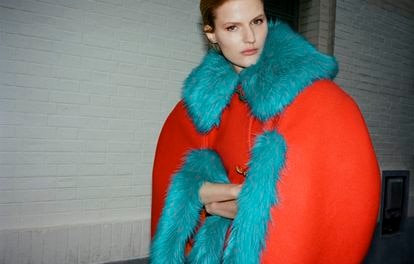Harris Reed’s entrance is a spectacle unto itself. A lanky 6′6″ silhouette bursts into the bar of the Parisian Rochechouart hotel, wearing a black jacket and impossible platform boots. When the 27-year-old native of Los Angeles lets down his red-haired Rapunzel mane with a theatrical gesture, hotel guests can’t help but be taken aback and, in all likelihood, wonder who this mythological creature is. “I don’t think it would be very easy to answer them,” he replies. After that, our chat with one of the most interesting designers of the past five years is as fast and dizzying as his rise to the top of an industry that constantly celebrates him: a graduate of the prestigious Central Saint Martins in London, at 27 Reed has achieved what others spend a lifetime trying to accomplish: Dressing Harry Styles for the first Vogue cover ever to feature a man, doing the same with Adele and Beyoncé and awakening interest in French fashion, so much so that he was named creative director at Nina Ricci in September last year. “A million things have happened to me in a very short time, and a lot of people around me were afraid that I wasn’t going to know how to handle it well. But my hyperactivity and ADD are my allies and let me do a hundred things at once and never get bored,” he jokes.
For many, the Puig group-owned Nina Ricci is a fashion house famous for its perfumes — the brand’s bestselling L’Air du Temps, created in 1948, is the first spicy floral fragrance in the history of perfumery — but it is not well known for its fashion. The founder, Italian Maria Adélaïde Giuseppa Nielli (who died in 1970 at age 87), created her own designs for other firms and didn’t have her own brand until she was almost 50, a pursuit supported by her son Robert Ricci. “For some reason there is a widespread idea of her as a woman dedicated to a romantic, ethereal silhouette, but she was a bold designer [and] ahead of her time,” Reed says. “It is clear that her archive — which is on par with the likes of Dior and Balmain — has not been explored as much as theirs.” The challenge had already been attempted by some of Reed’s predecessors, such as the tandem of Rushemy Botter and Lisi Herrebrugh, Englishman Peter Copping, Guillaume Henry and Olivier Theyskens, who was the most popular designer during his time at the firm between 2006 and 2010. When it was announced that Reed had been named creative director at Nina Ricci, many in the industry asked what the British-American designer of fluid and eccentric fashion, could bring to a 90-year-old French fashion house. “Freedom, fun, color and diversity in every sense,” Reed responds unreservedly. “At other companies, there is a manual about which shoe sells, which belt works and the bag to put everything in. Here, I can play around with the archive and start with a piece to add features of the fashion I promote, where everyone has a place and where dressing itself is a performance,” he argues.

This collection was unveiled last March to mixed reviews. On the catwalk, the model Precious Lee inaugurated a fashion show full of dramatic outfits in orange tulle and velvet, over-the-top bows and brimmed hats that combined with multicolored polka dots and neon feathers. For some, it was a celebration in every sense of the word; for others, it was a bawdy display far removed from French elegance. All in all, Reed made headlines for the day. “I didn’t plan to do something subtle or passable. I want to have an original point of view and to be the first to do what is thriving years later. That’s where my satisfaction resides.”

Reed’s obsession with breaking down the barriers between the masculine and the feminine is a classic theme that his colleagues, including Spain’s Alejandro Gómez Palomo and France’s Ludovic de Saint Sernin, have discussed for years. But in the Californian designer’s case, the impulse goes back to his childhood: he was raised by a former-model-turned-painter and a documentary filmmaker. “I have the sense that my childhood was like a mere 30-second elevator ride. I lived in a total of 28 houses before I went to college, and we kept moving. Seattle, Arizona, Washington, Oregon… You can imagine what it was like when I would arrive on the first day of school in a pink glitter skirt and say to my classmates, ‘Hi, I’m Harris, the gay kid starting today.’ Luckily, my mother understood my fashion ambition, even if at the time that meant my dressing up and wearing impossible outfits,” he says with a smile.
Life soon rewarded him. By the time he was a teenager, his family had moved back to his native Los Angeles. By then, Harris was devouring magazines like Teen Vogue and Women’s Wear Daily. A chance encounter with publicist Kelly Cutrone landed him an internship at her company, People’s Revolution Agency, and when he came of age, he got an interview to get into Central Saint Martins. “I walked in thinking I was king of the world and when the guy asked me for my favorite designer, I answered Alexander McQueen. His response was that he was dead and that my work was as bad as his. When he saw the tear in my eye, he smiled and told me I was in,” Reed explains. As a student, he admits, he was frustrated by his professors’ obsession with finding objective clients for his clothes: “They probably didn’t exist then, but the world was changing, and time has proven me right.”

When the pandemic began, Reed had to put everything on hold. He was only two months away from graduating. At that point, he would not have been able to finish his project if it hadn’t been for a woman named Elli Jafari. Then the manager of The Standard hotel (and now vice president of the hotel group), she lent him an empty room as a base of operations: “There, I was able to start placing orders and lay the foundations of my company on a temporary basis.” That “temporary” situation lasted for over two years, but it bore fruit: his own company, his role at the helm of Nina Ricci and his media-star status, which is associated with Miley Cyrus, Selena Gomez and Emma Watson. Then there was his debut on the Met red carpet with model Iman, his starring role in last year’s Fashioning Masculinities exhibit at the Victoria & Albert Museum and his collaborations with brands like Gucci and MAC Cosmetics.

Reed talks about this and many other things in Fluid: A Fashion Revolution, the book that Abrams will publish about his story in November 2023. With long hours of therapy and the support of his friends, his family and his partner — entrepreneur Eitan Senerman — he recounts episodes such as the bullying he suffered as a child. “I came to tell over and over again with laughter that I was beaten as a child and that it had helped me make beautiful dresses, but I was very aware that the trauma was still there,” he says. But there is something reaffirming and confident in Reed’s imposing presence, which he himself connects to that time in his life: “If someone sees you on the street and yells [a homophobic slur] at you because you’ve decided to wear what you want, it says more about that person than it does about you. For that reason and because life is short, and the world is in such chaos, it’s clear to me that the only point of doing what I do is to have fun along the way. There will be those who don’t understand that or don’t like it, but luckily I don’t work for them.”
CREDITS:
Photography: Pablo Sáez
Styling: Juan Cebrián
Model: Ireen Tabolova (Viva Barcelona).
Makeup: Camille Arnaud (Airport Agency).
Hair: Charlotte Dubreuil (MFT Agency).
Manicure: Huberte Cesarion (MFT Agency).
Production: Maia Hoetink.
Assistant photographer: Theophile Parat.
Styling assistant: Juliette Da Luz.
Sign up for our weekly newsletter to get more English-language news coverage from EL PAÍS USA Edition
This post was originally published on this site be sure to check out more of their content.









